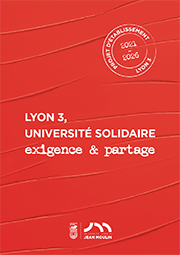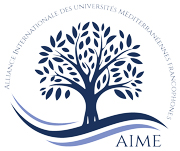AccueilRechercheProgrammes et productions scientifiquesThèsesThèses soutenuesThèses soutenues - 2006-2021Thèses soutenues - 2017
-
Partager cette page
- Recherche,
DEAT Dimitri
De la tribu à l’empire : le r?le des représentations primitives dans le processus de politisation nomade. L’influence du loup clanique dans la construction et l’expansion de l’Empire mongol de Gengis Khan
Publié le 16 octobre 2017 – Mis à jour le 13 décembre 2018
Thèse en Science politique, soutenue le 12 octobre 2017.
Participant à une certaine opacité dans son étude générale, la civilisation nomade des steppes Eurasiatiques fut longtemps considérée comme apolitique et symboliquement ancrée dans la barbarie. Cependant, cette dernière demeure un sanctuaire d’investigation scientifique à l’intérieur duquel le politique s’est considérablement manifesté par la création de nombreuses confédérations tribales. Opérant son entrée dans l’histoire de l’humanité en tant qu’élément perturbateur des sociétés sédentaires, les peuples de la Haute Asie ont ainsi participé, durant près de deux mille ans, à la chute, au bouleversement ou au renouveau des plus grandes civilisations. La création et l’expansion de l’empire gengiskhanide, dès le début du XIIIème siècle a permis de démontrer la faculté pour ces populations de pasteurs nomades d’opérer d’importantes modifications au sein même de leur morphologie sociale, et ce pour les besoins du politique et de la guerre vers l’extérieure. Cependant examinée de l’intérieur, cette civilisation atypique n’en reste pas moins problématique, notamment du fait de son actualisation culturelle. Cette dernière, accomplie au travers de concepts socio culturels alliant pensée animiste, spiritualité chamanique et utilisation de représentations sociales à aspects zoomorphiques, ne semble rentrer dans aucune grille de lecture impériale. La symbolique du loup est ainsi devenue omniprésente dans l’évolution de la morphologie tribale alta?que, participant à une unification massive des tribus turco-mongoles sous l’hégémonie hiérocratique de Gengis Khan. Devenu progressivement élément mythologique attracteur, l’animal carnassier s’est ainsi frayé une place de choix au sein de la mentalité collective nomade, participant directement au chamboulement de la morphologie tribale, pour les besoins du politique et de l’expansion de la civilisation des steppes en terres sédentaires. Au delà de la simple utilisation lycanthropique de l’ancêtre clanique, sa symbolique, réutilisée habilement par Gengis Khan, est en mesure de démontrer à la fois le dynamisme politique à apposer aux sociétés considérées à tort comme ?primitives?, tout comme l’instauration d’une identité sociale et d’une idéologie guerrière prédatrices. Etablissant de ce fait l’entité nomade comme antagonique mais complémentaire avec la pensée et l’histoire humaine sédentaire.
Participating in a certain opacity in it’s general study, the nomadic civilization of Eurasian steppe was long regarded as non-political and symbolically rooted in barbary. However, the latter remains a sanctuary of scientific investigation within which the political has significantly expressed itself by the creation of many Tribal confederations. It’s entry operates in the history of mankind as a disruptive element of sedentary societies. People of High Asia participated for almost two thousand years to the collapse, disruption or renewal of the world’s greatest civilizations. From the beginning of the 13th century the creation and expansion of the gengiskhanid empire enabled the demonstration of the faculty of these nomad pastors. They operated major changes in their social morphology for the political needs and because of the war outside. Examined from the interior, this atypical civilization remains questions. This is a result of cultural updating. The latter, accomplished through social and cultural concepts combining animist thinking, shamanist spirituality and the utilisation of social representations with zoomorphic aspects doesn’t fit any imperial cases studies. The symbolic representation of the wolf became ubiquitous in the development of the Tribal-Altaic morphology and participation of a massive unification of Turko Mongolian clans under the hierocratic hegemony of Gengis Khan. The carnivorous animal had progressively became administred as an attraction mythological element and cleared the way to the Tribal collective mentality. This participating directly to the disruption of Tribal morphology for the political needs and expansion of the steppe civilization in settled population territories. Beyond the single lycanthropic utilization of the Tribal ancestor, its symbolism skillfully reused by Gengis Khan demonstrates simultaneously the political dynamism to pin on societes mistakenly considered as ? primitive ?, and the establishment of a predatory social identity and war-making ideology created de facto the nomadic identity as an antagonist but complementary to the social wores and history of human sedentary.
Mots-clés : Politisation / Politicization ; Morphologie sociale / Social morphology ; Tribu / Tribe ; Empire / Empire ; Nomade / Nomadic ; Gengis Khan / Genghis Khan ; Loup / Wolf ; Représentation zoomorphique / Zoomorphic representation ; Asie centrale / Central Asia ; Mongolie / Mongolia
Directeur(s).trice(s) de thèse : M. Jean-Paul JOUBERT
Participating in a certain opacity in it’s general study, the nomadic civilization of Eurasian steppe was long regarded as non-political and symbolically rooted in barbary. However, the latter remains a sanctuary of scientific investigation within which the political has significantly expressed itself by the creation of many Tribal confederations. It’s entry operates in the history of mankind as a disruptive element of sedentary societies. People of High Asia participated for almost two thousand years to the collapse, disruption or renewal of the world’s greatest civilizations. From the beginning of the 13th century the creation and expansion of the gengiskhanid empire enabled the demonstration of the faculty of these nomad pastors. They operated major changes in their social morphology for the political needs and because of the war outside. Examined from the interior, this atypical civilization remains questions. This is a result of cultural updating. The latter, accomplished through social and cultural concepts combining animist thinking, shamanist spirituality and the utilisation of social representations with zoomorphic aspects doesn’t fit any imperial cases studies. The symbolic representation of the wolf became ubiquitous in the development of the Tribal-Altaic morphology and participation of a massive unification of Turko Mongolian clans under the hierocratic hegemony of Gengis Khan. The carnivorous animal had progressively became administred as an attraction mythological element and cleared the way to the Tribal collective mentality. This participating directly to the disruption of Tribal morphology for the political needs and expansion of the steppe civilization in settled population territories. Beyond the single lycanthropic utilization of the Tribal ancestor, its symbolism skillfully reused by Gengis Khan demonstrates simultaneously the political dynamism to pin on societes mistakenly considered as ? primitive ?, and the establishment of a predatory social identity and war-making ideology created de facto the nomadic identity as an antagonist but complementary to the social wores and history of human sedentary.
Mots-clés : Politisation / Politicization ; Morphologie sociale / Social morphology ; Tribu / Tribe ; Empire / Empire ; Nomade / Nomadic ; Gengis Khan / Genghis Khan ; Loup / Wolf ; Représentation zoomorphique / Zoomorphic representation ; Asie centrale / Central Asia ; Mongolie / Mongolia
Directeur(s).trice(s) de thèse : M. Jean-Paul JOUBERT
Membres du jury :
M. Gérard CHALIAND, géostratège et écrivain,
M. Christian GRATALOUP, Professeur des universités émérite, Université Paris Diderot,
M. Jean-Vincent HOLEINDRE, Professeur des universités, Université de Poitiers,
M. Jean-Paul JOUBERT, Professeur des universités émérite, Université Jean Moulin Lyon 3,
M. Jean LECA, Professeur à la retraite, IEP de Paris.
Président.e du jury : M. Christian GRATALOUP
Equipe d'accueil : Francophonie
M. Christian GRATALOUP, Professeur des universités émérite, Université Paris Diderot,
M. Jean-Vincent HOLEINDRE, Professeur des universités, Université de Poitiers,
M. Jean-Paul JOUBERT, Professeur des universités émérite, Université Jean Moulin Lyon 3,
M. Jean LECA, Professeur à la retraite, IEP de Paris.
Président.e du jury : M. Christian GRATALOUP
Equipe d'accueil : Francophonie
Décision : Admis
Documentation
Mise à jour : 13 décembre 2018







